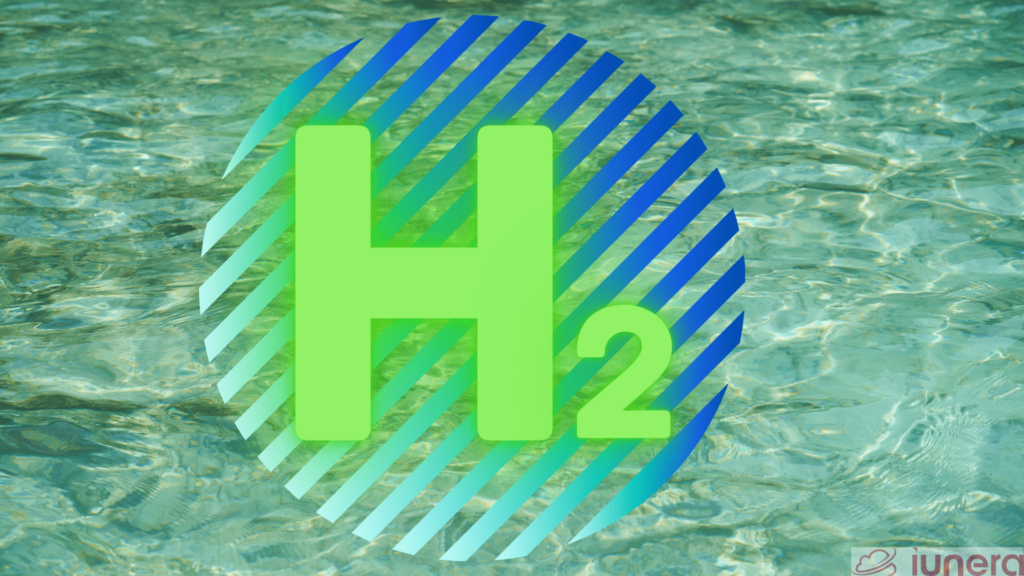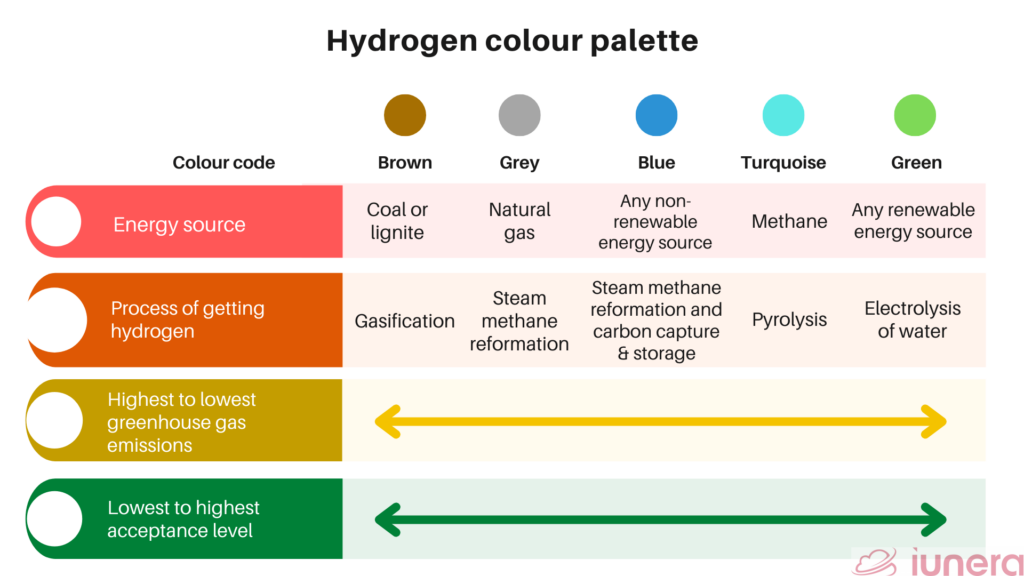This post is also available in: Deutsch (German)
Green hydrogen has now become a hot topic as the world is taking a heated interest in green hydrogen’s role in empowering the energy transition. With that said, this article aims to introduce green hydrogen and explain Big Data‘s role in producing and using green hydrogen.

Heated interest in green hydrogen
In line with Europe’s goal to become the first climate-neutral continent in 2050, the European Commission published a hydrogen strategy plan in July 2020. In fact, the European Union has set out to build 40 gigawatts of renewable hydrogen electrolysers by 2030, which will require €470 billion worth of public and private investments.
European aeroplane manufacturer Airbus has plans to develop hydrogen-powered aeroplanes for zero carbon emission flights by 2035. Meanwhile, energy companies Statkraft and Energiepark Emden join hands to build 50 megawatts of electrolysers to produce and distribute green hydrogen for public and private transport in East Frisia, Germany.
But this interest is not limited to Europe as several projects and plans are already underway worldwide. An example of this is Japan, which has one of the world’s largest green hydrogen plant in Fukushima with a 10-megawatt electrolyser.
But to understand this hype for green hydrogen, we’ll have to understand green hydrogen itself.
Why is it a hot topic?
Hydrogen can be obtained from either hydrocarbon sources or water (basically, anything that contains hydrogen). There are several ways to produce hydrogen, as shown in the colour code of the hydrogen production.

Green hydrogen is derived from splitting water molecules using electricity in a process known as electrolysis, which uses an electrolyser. Because green hydrogen only requires water and renewable energy to split the water molecules into hydrogen and oxygen, which leaves no room for carbon emissions, it’s considered the eco-friendliest way of getting hydrogen.
Having an eco-friendly alternative is especially important in the age of increasing global energy demand, estimated by the International Energy Agency (IEA) to be a 25-30% increase by 2040. Just imagine meeting that demand the old fashion way.
“Right now, renewables can be used to pump the grid, but that’s almost it. You can’t put solar or wind power into your car or a plane. However, green hydrogen created by solar and wind power has the potential to do that.”
Haim Israel, head of Thematic Investing Strategy at BofA Global Research, on the significance of green hydrogen.
On top of being sustainable, green hydrogen is also versatile as it can also be transformed into electricity and used for domestic, commercial, industrial and mobility purposes. Hydrogen can play a huge role in the provision of electricity, heat, industry, transport and energy storage in a low-carbon energy system.
BUT, it’s expensive! Producing 1 kg of hydrogen requires 9kg of water and costs $2.50-4.50 per kg, so there are doubts about the profitability of green hydrogen. Another barrier to adopting green hydrogen production is the difficulty in storing and transporting hydrogen due to its low levels of density, efficiency in moving hydrogen, efficiency in refuelling and storage system durability.
BUT, the good news is that these obstacles will become less of a problem as the world increasingly switches to zero-carbon solutions, leading to a greater scale of green hydrogen and hence, a reduced production cost. The factors behind this reduced cost are:
- a 50% drop in the cost of electrolysers in the past 5 years (80% drop for China) and another 60-90% drop by 2030 is expected;
- falling renewable energy costs;
- incentives for governments to shift to a cleaner, greener economy like the European Green Deal and carbon emission taxes;
- and of course, technological advances to increase production efficiency and green hydrogen versatility.
It should also be noted that hydrogen prices might change according to the weather. For example, if the hydrogen is produced using solar power during the summer and there’s plenty of water, then there’s a huge supply of hydrogen, reducing the hydrogen price. To further reduce the hydrogen price, weather predictions are useful for optimising the efficiency of solar-powered hydrogen production.
Applying Big Data in green hydrogen
Part of the technological advances powering green hydrogen is data. Data intelligence (IoT data and AI) is used by a company called Kaiserwetter to address several green hydrogen challenges including:
- addressing the costs of renewable energy needed to produce the amount of green hydrogen needed;
- making hard decisions about producing, storing, delivering and selling green hydrogen easier;
- predicting production costs based on a combination of the technical, financial, energy market and meteorological data;
- calculating supply and demand patterns for supply-side investors to make decisions about electrolysers, pipelines and other distribution facilities.
Another real-life example of a company that comes up with Big Data and AI solutions for green hydrogen production is Green Hydrogen Solutions (wow, self-explanatory).
“We combine big data and AI with innovative technologies to develop lower-than-average cost projects that produce green hydrogen at competitive prices linked to demand.”
Green Hydrogen Solutions on what makes them jump out of bed.
The projects done by this company were:
- processing variable renewable electricity (VRE) data to simulate and determine the potential for green hydrogen production in South Africa, Germany and the US state of California;
- processing renewable energy resources capacity data to evaluate the building of green hydrogen production infrastructure;
- processing VRE data to simulate and forecast the application of green hydrogen for Helsinki’s heating needs by 2035;
- processing weather, VRE and pipeline storage data to simulate the potential for green hydrogen production in the UK.
The case for using hydrogen to power heating systems in smart homes can also benefit from weather forecasts (and predicting for how long people are staying in the smart home). So, when renewable energy is cheap, hydrogen can be derived using this energy via electrolysis and stored for heating. This can also be applied on a larger scale like storing excess energy in old underground gas caves, the data of which can then be combined with predictive analytics to estimate how much people will consume.
Big Data can also be used in managing hydrogen-powered buses and trains. While more research and innovation initiatives are required for applying hydrogen and fuel cell technology in trains, buses face the challenge of finding fueling stations when needed, so the data of the routes, locations of hydrogen fueling stations and bus fuel tank levels need to be analysed to make predictions when fueling is required.
All about the resources!
To put it simply, the use case for green hydrogen might be pretty similar to the other sustainability use cases. The relevant factors for producing green hydrogen are taken into consideration and analysed to make predictions and decisions about the allocation of natural resources and investments.
The green hydrogen revolution might also be driven by a good understanding of science and economics. Without science, we wouldn’t know if green hydrogen is eco-friendlier. Without economics, we wouldn’t see a possibility of green hydrogen achieving greater economies of scale.
Science and economics make up the relevant factors that Big Data and AI use as input to derive the output: The answers to our questions about producing green hydrogen.
More importantly, it might also be driven by an understanding that we can’t change how nature works but we can instead create and use tools to adapt to nature. Perhaps, this quote sums up the situation for green hydrogen:
“We can’t change the wind, we can only adjust the sails.”
Most likely attributed to Cora L. V. Hatch in 1859
